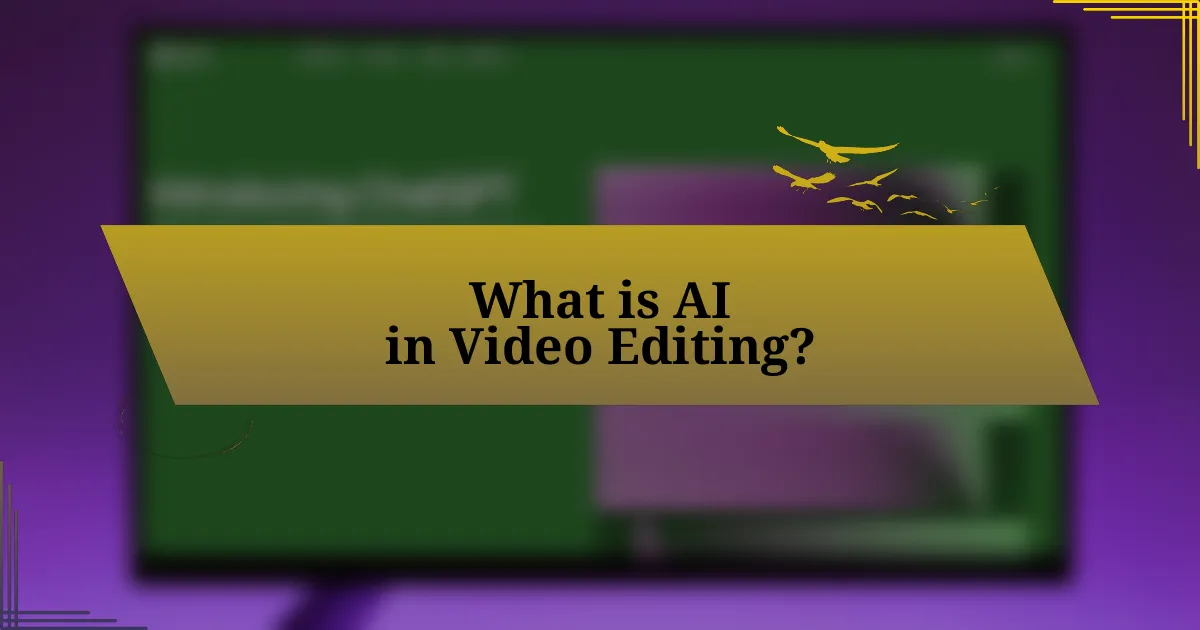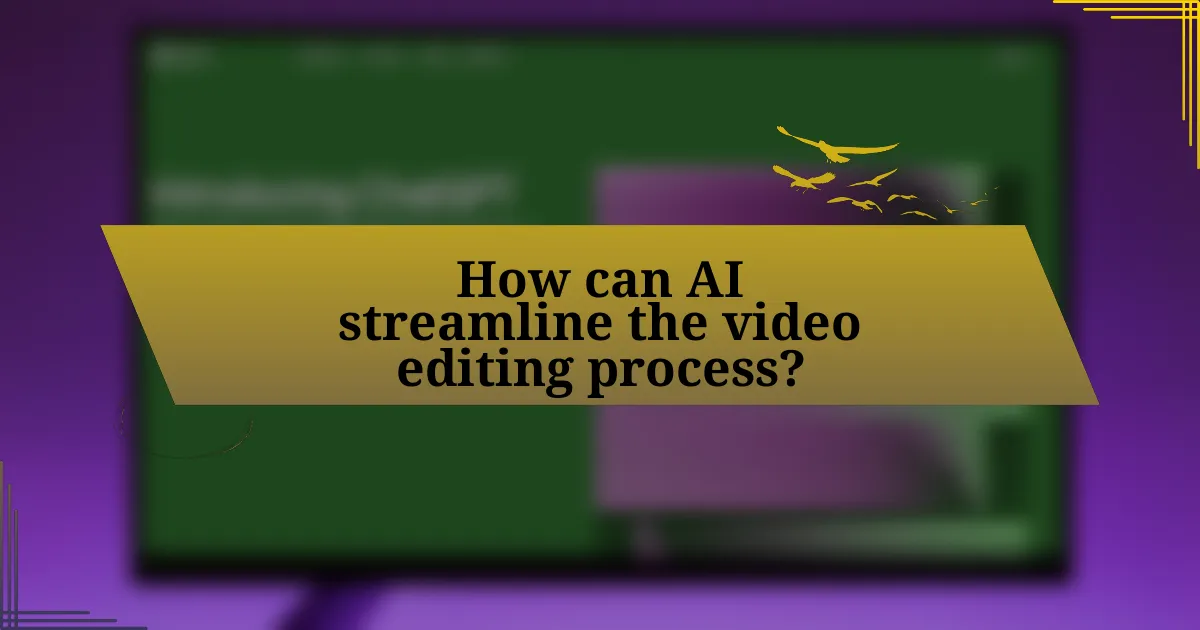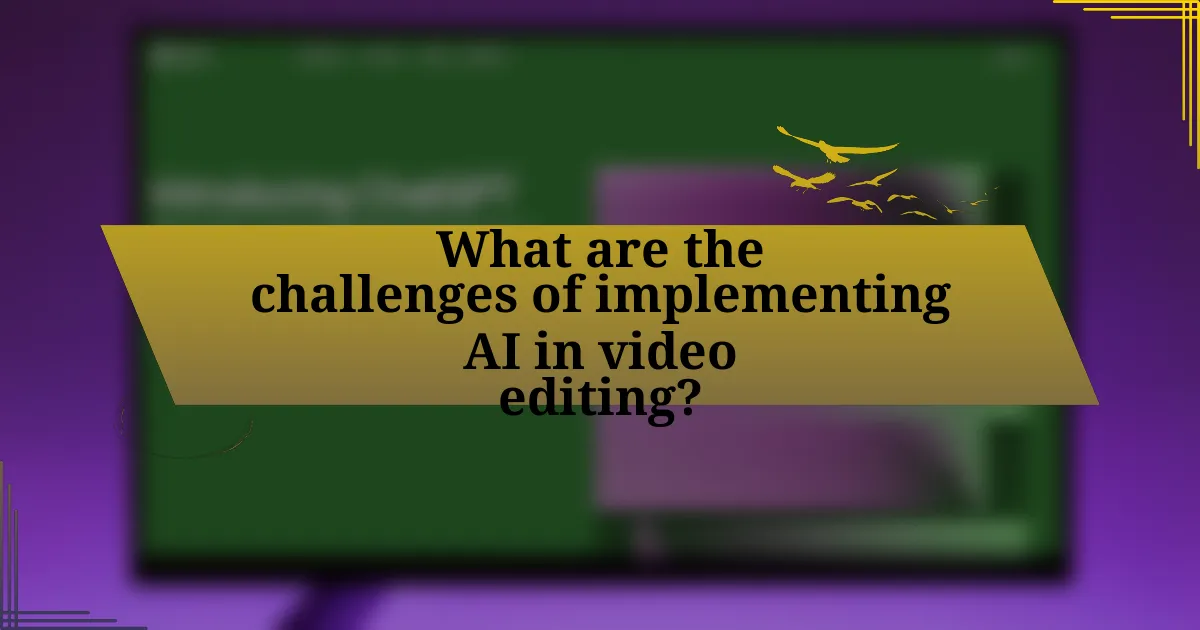AI in video editing refers to the application of artificial intelligence technologies to automate and enhance various aspects of the video editing process, including scene detection, color correction, and audio enhancement. The article explores how AI integrates into video editing workflows, highlighting key tools such as Adobe Premiere Pro and DaVinci Resolve, which improve efficiency and creativity by automating repetitive tasks. It also addresses the advantages of AI, such as increased editing speed and improved sound quality, while discussing challenges like biases in algorithms and the need for high-quality training data. Furthermore, the article outlines best practices for effective AI integration and future trends in the industry, emphasizing the potential for continuous learning and innovation in video editing tools.

What is AI in Video Editing?
AI in video editing refers to the use of artificial intelligence technologies to automate and enhance various aspects of the video editing process. This includes tasks such as scene detection, color correction, audio enhancement, and even generating video content based on user inputs. For instance, AI algorithms can analyze footage to identify key moments, allowing editors to streamline their workflow by quickly locating the best clips. Additionally, AI-driven tools can improve efficiency by suggesting edits or applying effects automatically, which can significantly reduce the time required for manual editing.
How does AI technology integrate into video editing workflows?
AI technology integrates into video editing workflows by automating repetitive tasks, enhancing content analysis, and improving editing efficiency. For instance, AI algorithms can automatically generate scene cuts, suggest edits based on content analysis, and even assist in color correction and audio enhancement. According to a study by Adobe, AI-driven features in video editing software can reduce editing time by up to 30%, allowing editors to focus on creative aspects rather than technical details. This integration not only streamlines the workflow but also enhances the overall quality of the final product.
What are the key AI tools used in video editing?
Key AI tools used in video editing include Adobe Premiere Pro with Sensei, DaVinci Resolve, and Magisto. Adobe Premiere Pro utilizes Adobe Sensei to automate tasks like color correction and audio enhancement, significantly speeding up the editing process. DaVinci Resolve incorporates AI features for facial recognition and scene detection, allowing editors to organize footage efficiently. Magisto leverages AI to analyze video content and automatically create polished videos, making it accessible for users with minimal editing experience. These tools demonstrate the integration of AI in enhancing video editing workflows by improving efficiency and creativity.
How do these tools enhance the editing process?
AI tools enhance the editing process by automating repetitive tasks, improving efficiency, and providing advanced features like scene detection and color correction. For instance, AI algorithms can analyze footage to identify key moments, allowing editors to focus on creative decisions rather than manual sorting. Additionally, tools like Adobe Premiere Pro’s Sensei technology utilize machine learning to suggest edits and enhance audio quality, significantly reducing the time spent on technical adjustments. This automation not only speeds up the workflow but also allows editors to produce higher-quality content in less time.
What are the advantages of using AI in video editing?
The advantages of using AI in video editing include increased efficiency, enhanced creativity, and improved accuracy. AI algorithms can automate repetitive tasks such as cutting, color correction, and audio syncing, significantly reducing the time required for editing. For instance, Adobe’s Sensei technology utilizes AI to streamline workflows, allowing editors to focus on creative aspects rather than technical details. Additionally, AI can analyze footage to suggest edits or highlight the best moments, which enhances the creative process by providing valuable insights. Furthermore, AI-driven tools can ensure consistency in editing styles and improve the overall quality of the final product, as seen in platforms like Magisto, which uses AI to create polished videos from raw footage.
How does AI improve efficiency in video editing?
AI improves efficiency in video editing by automating repetitive tasks, such as scene detection, color correction, and audio syncing. This automation allows editors to focus on creative aspects rather than time-consuming technical processes. For instance, AI algorithms can analyze footage to identify key moments, enabling faster selection of clips. Additionally, AI-driven tools can enhance video quality through automatic adjustments, significantly reducing the time spent on manual edits. Studies have shown that using AI in video editing can cut production time by up to 50%, demonstrating its effectiveness in streamlining workflows.
What impact does AI have on creativity in video editing?
AI significantly enhances creativity in video editing by automating repetitive tasks and providing advanced tools for content generation. This allows editors to focus more on artistic decisions rather than technical details. For instance, AI algorithms can analyze footage and suggest optimal cuts, transitions, and effects, which streamlines the editing process and fosters innovative storytelling. Research from Adobe indicates that AI-driven features in their software can reduce editing time by up to 50%, enabling creators to experiment more freely with their projects.

How can AI streamline the video editing process?
AI can streamline the video editing process by automating repetitive tasks, enhancing content organization, and improving editing efficiency. For instance, AI algorithms can analyze footage to identify key moments, such as the best takes or significant actions, which reduces the time editors spend sifting through hours of raw video. Additionally, AI-powered tools can assist in color correction, audio enhancement, and even suggest edits based on predefined styles or trends, thereby accelerating the overall workflow. Studies have shown that using AI in video editing can reduce editing time by up to 50%, allowing creators to focus more on storytelling and creativity rather than technical details.
What specific tasks can AI automate in video editing?
AI can automate several specific tasks in video editing, including scene detection, color correction, audio enhancement, and video summarization. Scene detection allows AI to identify and segment different parts of a video, making it easier for editors to navigate and select clips. Color correction can be automated through AI algorithms that analyze footage and adjust color balance, brightness, and contrast to achieve a consistent look. Audio enhancement involves AI tools that can automatically remove background noise and balance audio levels, improving overall sound quality. Video summarization uses AI to create concise highlights from longer videos by identifying key moments, significantly reducing editing time. These capabilities streamline the editing process, allowing creators to focus on more creative aspects of their work.
How does AI assist in video organization and tagging?
AI assists in video organization and tagging by automating the identification and categorization of video content. Through techniques such as computer vision and natural language processing, AI analyzes video frames and audio to extract relevant metadata, enabling efficient tagging based on visual and auditory cues. For instance, AI can recognize objects, scenes, and spoken words, allowing for precise tagging that enhances searchability and organization. This capability significantly reduces the time required for manual tagging, as evidenced by studies showing that AI can improve tagging accuracy by up to 90%, streamlining the video editing workflow.
What role does AI play in color correction and grading?
AI plays a significant role in color correction and grading by automating and enhancing the process, allowing for more precise adjustments and faster workflows. Through machine learning algorithms, AI can analyze footage, identify color imbalances, and suggest or apply corrections based on learned patterns from vast datasets of professionally graded content. For instance, AI tools can automatically match colors across different shots, ensuring consistency and saving editors considerable time. Additionally, AI can assist in creating looks or styles by learning from user preferences and applying similar adjustments across multiple clips, thereby streamlining the editing process.
How can AI enhance audio editing in videos?
AI can enhance audio editing in videos by automating tasks such as noise reduction, audio leveling, and dialogue enhancement. These capabilities allow editors to save time and improve audio quality significantly. For instance, AI algorithms can analyze audio tracks to identify and eliminate background noise, resulting in clearer sound. Additionally, AI can automatically adjust audio levels to ensure consistent volume throughout the video, which is crucial for viewer engagement. Studies have shown that AI-driven tools can reduce editing time by up to 50%, making the workflow more efficient and effective.
What AI tools are available for audio enhancement?
AI tools available for audio enhancement include Adobe Audition, iZotope RX, and Auphonic. Adobe Audition offers features like noise reduction and audio restoration, making it suitable for professional audio editing. iZotope RX is known for its advanced audio repair capabilities, including spectral editing and dialogue isolation, which are essential for high-quality audio production. Auphonic provides automated audio processing, including leveling and noise reduction, which streamlines the enhancement process for content creators. These tools are widely recognized in the industry for their effectiveness in improving audio quality.
How does AI improve sound quality and synchronization?
AI improves sound quality and synchronization by utilizing advanced algorithms to analyze and enhance audio signals in real-time. These algorithms can reduce noise, optimize frequency ranges, and apply dynamic range compression, resulting in clearer and more balanced sound. Additionally, AI-driven tools can automatically sync audio tracks with video by detecting and aligning waveforms, ensuring that sound matches the visual elements accurately. Research has shown that AI can achieve synchronization with an accuracy of up to 95%, significantly reducing the time and effort required for manual adjustments.

What are the challenges of implementing AI in video editing?
The challenges of implementing AI in video editing include the complexity of integrating AI algorithms with existing software, the need for high-quality training data, and the potential for biased outputs. Integrating AI requires significant technical expertise and resources, which can be a barrier for many video editing professionals. Additionally, AI systems rely on large datasets for training; if these datasets are not diverse or high-quality, the AI may produce suboptimal results. Furthermore, biases in training data can lead to skewed or unfair outcomes in the editing process, impacting the final product’s quality and representation.
What limitations should editors be aware of when using AI?
Editors should be aware that AI tools can lack contextual understanding and may produce inaccurate or irrelevant content. This limitation arises because AI algorithms primarily rely on patterns in data rather than genuine comprehension of the subject matter. For instance, AI may misinterpret nuances in video content, leading to inappropriate edits or suggestions that do not align with the intended message. Additionally, AI-generated outputs can sometimes reflect biases present in the training data, which can affect the quality and fairness of the editing process. These limitations highlight the necessity for human oversight to ensure that the final product meets the desired standards and accurately conveys the intended narrative.
How can biases in AI algorithms affect video editing outcomes?
Biases in AI algorithms can lead to skewed video editing outcomes by favoring certain styles, subjects, or demographics over others. For instance, if an AI algorithm is trained predominantly on content featuring specific ethnicities or genders, it may inadvertently prioritize those representations in edited videos, resulting in a lack of diversity. Research has shown that biased training data can perpetuate stereotypes and reinforce existing inequalities in media representation, as highlighted in the study “Algorithmic Bias Detectable in AI Systems” by Barocas and Selbst. This can ultimately affect audience perception and engagement, as the edited content may not accurately reflect the broader societal context.
What are the potential costs associated with AI tools?
The potential costs associated with AI tools include initial investment, ongoing maintenance, and operational expenses. Initial investment costs can range from thousands to millions of dollars depending on the complexity and scale of the AI solution. For example, a study by McKinsey found that companies investing in AI typically allocate between $1 million and $10 million for implementation. Ongoing maintenance costs, which include software updates, hardware upgrades, and technical support, can add an additional 15-20% of the initial investment annually. Operational expenses may also arise from the need for skilled personnel to manage and operate AI tools, with salaries for AI specialists averaging around $120,000 per year in the United States.
How can editors overcome challenges when using AI?
Editors can overcome challenges when using AI by integrating AI tools that enhance their workflow while maintaining creative control. By selecting AI software that automates repetitive tasks, such as video tagging or color correction, editors can save time and focus on more complex creative decisions. Research indicates that 70% of video editors report increased efficiency when utilizing AI-driven tools, allowing them to produce higher-quality content in shorter timeframes. Additionally, continuous training on AI technologies and collaboration with AI developers can help editors better understand and leverage these tools, ensuring they align with their artistic vision and project requirements.
What best practices should be followed for effective AI integration?
Effective AI integration requires a clear strategy that aligns AI capabilities with specific business goals. Organizations should begin by identifying the areas within their video editing workflow that can benefit from AI, such as automating repetitive tasks or enhancing content personalization.
Next, it is crucial to ensure data quality and availability, as high-quality data is essential for training AI models effectively. Additionally, fostering collaboration between technical teams and domain experts can enhance the understanding of AI applications and improve implementation outcomes.
Regularly evaluating AI performance and making iterative improvements based on feedback will also contribute to successful integration. According to a McKinsey report, companies that effectively integrate AI into their workflows can see productivity increases of 20-30%.
How can continuous learning improve AI usage in video editing?
Continuous learning enhances AI usage in video editing by enabling algorithms to adapt and improve over time based on new data and user interactions. This adaptability allows AI systems to refine their editing techniques, such as scene detection, color correction, and audio synchronization, leading to more efficient workflows and higher-quality outputs. For instance, AI models trained on diverse video content can learn to recognize and apply stylistic choices that align with current trends, thereby increasing the relevance and appeal of the edited videos.
What are the future trends of AI in video editing?
The future trends of AI in video editing include increased automation, enhanced personalization, and improved collaboration tools. Automation will streamline repetitive tasks such as cutting, color correction, and audio syncing, allowing editors to focus on creative aspects. Enhanced personalization will enable AI to analyze viewer preferences and tailor content accordingly, improving engagement. Improved collaboration tools will facilitate real-time editing and feedback among teams, regardless of location. These trends are supported by advancements in machine learning algorithms and the growing demand for efficient content creation in the digital landscape.
How is AI expected to evolve in the video editing industry?
AI is expected to evolve in the video editing industry by increasingly automating complex tasks, enhancing creativity, and improving efficiency. Advanced algorithms will enable features such as automatic scene detection, intelligent color correction, and real-time editing suggestions, which will streamline the editing process. For instance, tools like Adobe Premiere Pro and DaVinci Resolve are already integrating AI capabilities to assist editors in tasks like audio enhancement and video stabilization, demonstrating the trend towards greater automation. As AI technology continues to advance, it will likely lead to more sophisticated editing tools that can learn from user preferences and adapt to individual editing styles, further transforming the workflow in video production.
What innovations are on the horizon for AI video editing tools?
Innovations on the horizon for AI video editing tools include advanced automation features, enhanced real-time collaboration capabilities, and improved machine learning algorithms for content analysis. These advancements will allow editors to streamline their workflows significantly, enabling faster editing processes and more intuitive user experiences. For instance, tools that leverage deep learning can automatically identify key moments in footage, suggest edits, and even generate content based on user preferences, as seen in recent developments by companies like Adobe and Magisto. Additionally, the integration of AI-driven audio and visual effects will further enhance the creative possibilities for video editors, making it easier to produce high-quality content efficiently.
What practical tips can enhance your video editing workflow with AI?
Utilizing AI tools can significantly enhance your video editing workflow by automating repetitive tasks and improving efficiency. For instance, AI-driven software can analyze footage to suggest optimal cuts, transitions, and effects, saving editors substantial time. Additionally, AI can assist in color correction and audio enhancement, ensuring a polished final product with minimal manual intervention. Research indicates that AI can reduce editing time by up to 50%, allowing editors to focus on creative aspects rather than technical details.
